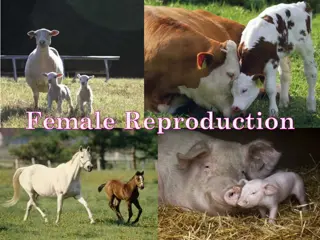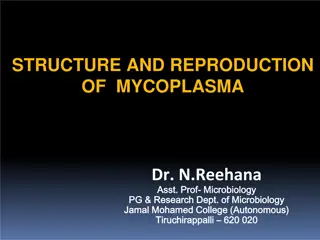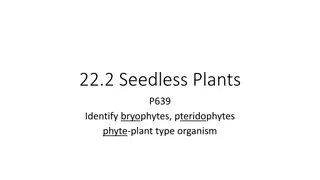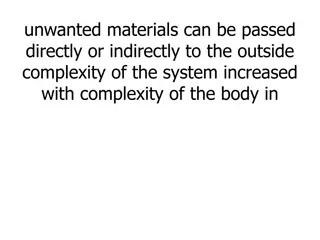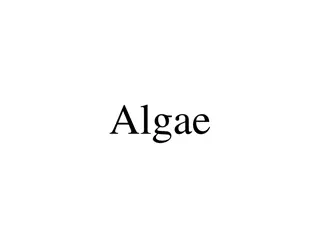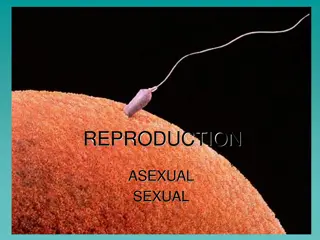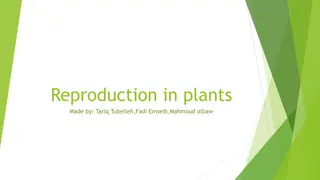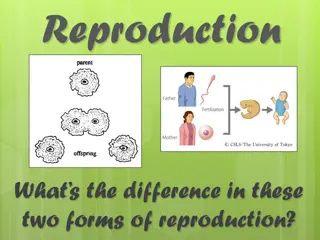General Characteristics and Reproduction in Pteridophytes
Majority of living Pteridophytes, including terrestrial, aquatic, xerophytic, and epiphytic species, exhibit unique characteristics in their plant body structure. They possess sporophytic plant bodies with differentiated root, stem, and leaves, showcasing a variety of forms and adaptations. Reproduction in Pteridophytes involves spore production within sporangia, leading to the development of multicellular gametophytic bodies called prothalli. The spores give rise to male and female prothalli, depending on the species' reproductive strategy.
Download Presentation

Please find below an Image/Link to download the presentation.
The content on the website is provided AS IS for your information and personal use only. It may not be sold, licensed, or shared on other websites without obtaining consent from the author.If you encounter any issues during the download, it is possible that the publisher has removed the file from their server.
You are allowed to download the files provided on this website for personal or commercial use, subject to the condition that they are used lawfully. All files are the property of their respective owners.
The content on the website is provided AS IS for your information and personal use only. It may not be sold, licensed, or shared on other websites without obtaining consent from the author.
E N D
Presentation Transcript
General Characters General Characters Majority of the living Pteridophytes are terrestrial and prefer to grow in cool, moist and shady places e.g., ferns. Some members are aquatic (e.g., Marsileci, Azolla), xerophytic (e.g., Selaginella rupestris, Equisetum) or epiphytic (e.g., Lycopodium squarrosum) Majority of the Pteridophytes are herbaceous but a few are perennial and tree like (e.g., Angiopteris). Smallest Pteridophyte is Azolla (an aquatic fern) and largest is Cyathea (tree fern). Plant body is sporophytic and can be differentiated into root, stem and leaves. Roots are adventitious in nature with monopodial or dichotomous branching. Stem is usually branched. Branching is monopodial or dichotomous. Branches do not arise in the axil of the leaves. In many Pteridophytes stem is represented by rhizome. Leaves may be small, thin, scaly (microphyllous e.g., Equisetum), simple and sessile (e.g., Selaginella) or large and pinnately compound (megaphyllous e.g., Dryopteris). Vascular tissue is present in stem and root. It consists of xylem and phloem. Xylem consists of tracheids only and phloem has only sieve tubes. The steel is protostele (e.g., Rhynia, Lycopodium), siphonostele (e.g., Equisetum), dictyostele (Adiantum) or polycyclic (e.g., Angiopteris).
Microphyllous-Lycopodium Megaphyllous-Pteris
Reproduction in Pteridophytes Reproduction takes place by means of spores which are produced inside sporangia. The development of the sporangium may be leptosporangiate (sporangium originates from a single cell) or eusporangiate (sporangium develops from a group of cells). Spores on germination give rise to multicellular gametophytic bodies called prothalli (sing. prothallus). In homosporous Pteridophytes prothalli are monoecious (antheridia and archegonia develop on the same prothallus). In heterosporous species prothalli are always dioecious. Microspores on germination give rise to male prothalli and megaspores to the female prothalli.
On the basis of development, the sporangia in into two types: On the basis of development, the sporangia in Pteridophytes into two types: Pteridophytes are divided are divided ( (i i) Eusporangiate Type Sporangium develops from group of superficial cells. These cells divide periclinally into primary wall layers and inner primary sporogenous cells . The outer wall layers form the wall of the sporangium while inner sporogenous cells divide meiotically and form spores ) Eusporangiate Type: (ii) This type of sporangium arises from a single superficial cell. It divides transversely to form an outer and an inner cell. While the inner cell forms the stalk, the entire sporangium develops from the outer cell. The outer cell divides by three successive periclinal divisions and in this way a tetrahedral apical cell is formed. It divides by periclinal division to form the outer jacket cell and inner primary sporogenous cell . Jacket cell forms the single layered sporangial wall while primary sporogenous cell divides into tapetal initial and sporogenous tissue. Sporogenous tissue divides meiotically to give rise to haploid spores while tapetal initial forms two layered tapetum (ii) Leptosporangiate Leptosporangiate Type Type:
Sporangium- Equisetum Sporangium- Dryopteris
Reproduction (cont.) Antheridia and archegonia are developed on prothalli. Antheridium is surrounded by a single layered sterile jacket. Archegonium consists of four vertical rows of neck cells, 1-2 neck canal cells, ventral canal cell and egg. Antherozoids are unicellular, biflagellate (e.g., Selaginella) or multiflagellate (e.g., Equisetum and ferns) and motile. Antherozoids are attracted towards the neck of the archegonium Water is essential for fertilization (zooidogamous). Fertilization results in the formation of zygote or oospore, which ultimately develops into well-developed sporophyte. The fertilized egg divides transversely or vertically. Another cross wall forms a quadrant stage producing stem, leaf, foot and root. Plants show heteromorphic alternation of generation. The main plant body is sporophytic and forms a dominant phase in the life cycle.
Majority of the Pteridophytes are homosporous e.g., Lycopodium, Pteris etc. Spores on germination produce monoecious gametophyte. The gametophytes produces gametes which fertilizes producing zygote. The zygote foprms the sporophyte. Some Pteridophytes are heterosporous and produce two types of spores: microspores and megaspores. Microspores on germination produce male gametophyte (prothallus) while megaspores on germination produce female gametophyte (prothallus). So, the prothalli are dioecious. Antheridia and archegonia develop on the same prothallus (monoecious) or on different prothalli (dioecious). The male and female gametes fuse to form zygote which develops into sporophyte. Thus, the life cycle of a Pteridophyte consists of an alternate succession of sporophytic and gametophytic generations



